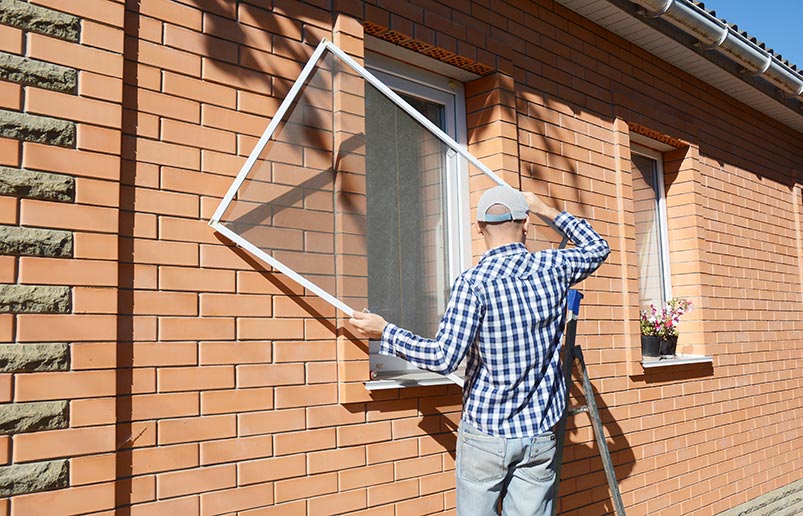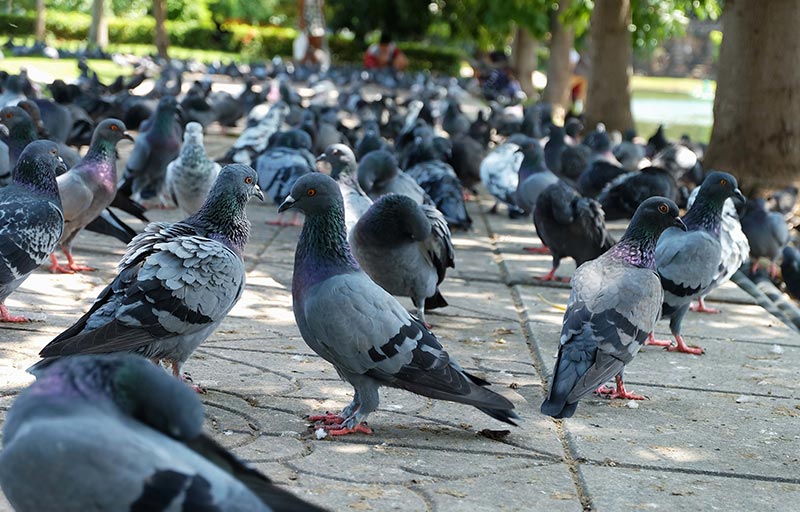|
Topping every other city in the survey, 41 percent of New Orleans households reported seeing cockroaches within the house, according to a Bloomberg compilation of 2015 American Housing Survey data. Roaches and other common pests are frequently found in warm, humid climates. If pesky cockroaches are present, there are most likely additional types of pests residing in dark crevasses throughout the home. New Orleans pest control takes ongoing commitment and dedication to keep buildings free from these unwanted inhabitants. Pest-proofing a structure is often one of the best ways to keep bugs out of the home. It can be easier to keep them outside compared to getting them to move back outdoors once they have taken up residence in your home. Below are seven helpful tips for pest-proofing any structure. The equipment referred to is typically available at local hardware or home improvement stores. 1. Repair Door and Window Screens
Repairing door and window screen tears or gaps is one of the first steps to take when making New Orleans pest control efforts. These holes can allow entry of mosquitoes, flies, gnats or other insects into the home. Even after eliminating any openings, some insects may be small enough to fit through standard mesh window screens. Denying entrance to these tiny bugs may mean that windows must be kept closed during certain times of the year. 2. Apply Caulk to Cracks Cracks can form around doors, fascia boards, windows, or other surfaces on the outside of the home. A high-quality acrylic latex or silicone caulk can plug those holes to keep insects out. Latex-based caulks clean up easily with water. Caulked surfaces can be painted to match the surrounding area. For those with less experience, caulks that are clear after drying can be easier to use because mistakes will not show as well. Before sealing a crack, clear it of any peeling substances. For a clean look, apply the caulk bead to the surface and smooth it with a damp rag or moistened finger. A good caulking gun can make all the difference when tackling New Orleans pest control projects. Look for these handy features:
3. Install Door Sweeps Door sweeps or thresholds installed at the base of all exterior, sliding glass and garage doors can block accessible entrances for many pests. Lie on the floor and check for light visible under each door. Pay particular attention to the corners, where there is more likely to be a gap. Openings as small as 1/16 inch or less can permit insects and spiders to access the structure’s interior. In addition to insects, mice can enter through a hole the size of a pencil’s diameter, and it only takes a one-half inch gap to give access to a rat. New Orleans pest control often starts with blocking these common openings. Caulk applied along the outside bottom edges and sides of exterior doors can obstruct ants and other small insects. Foam weather-stripping applied to the bottom track of a sliding glass door can seal this popular entrance point. Garage doors can be fitted with a rubber bottom seal to eliminate space between the door and the driveway floor. 4. Seal Utility Openings Pipes and wires often enter a home’s foundation and sidings through utility openings. When left unsealed, these can become beacons for bugs to enter the building. Examine openings for outdoor faucets, clothes dryer vents, gas meters, receptacles and wiring that come into the building. Plug holes with cement, caulk, expandable urethane foam, copper mesh, steel wool, or any other suitable sealant. As the seasons change, check these entry points at least a couple of times per year to ensure that the closures remain intact. 5. Place Wire Mesh Over Vents A thorough New Orleans pest control strategy often includes installing wire mesh or hardware cloth throughout the attic, crawl spaces, roof and vents. Because of the material’s razor-sharp texture, use gloves when cutting and installing the coverings. In addition to bugs, the mesh can also successfully keep birds, squirrels, bats, and rodents from living in rarely used attic areas. 6. Apply Barrier Treatments An exterior insecticide perimeter barrier can be established to keep pests even further away from the structure. Long-lasting liquid formulations are available to spread around strategic areas of the home or other structures. Many lawn and garden shops stock different types of insecticides, some of which may be specially formulated to combat New Orleans pest control issues. Apply the insecticide around exterior doors, crawl space entrances, garage door openings, vents and utility openings throughout the foundation and underneath the home’s siding. Use a hose-end or compressed-air sprayer to dispense the insecticide. Homeowners may also want to treat a perimeter band around the building, ranging from two to six feet in width. 7. Evaluate Lighting While outdoor lighting is often used for safety reasons, it can also attract more pests towards the building, particularly when entrances are illuminated. Certain spectrums of outdoor lights, such as those with wavelengths less than 550 nanometers, can increase pest attraction. When lighting an area with pest-attracting lights, take other New Orleans pest control measures to secure the area. Controlling the entrance of unwanted pests into your home is an ongoing process, not a one-time event. It has been a sanitation and health issue for centuries, considering that as far back as the 1400s, fleas carried on the back of rats transmitted the bubonic plague. More recently, bugs and other types of vermin have been found to trigger asthma and allergies, in addition to creating an unclean environment that contains saliva, feces, body parts and partially eaten food. Stronger strains of pests are proliferating as well, including biting bed bugs, invasive ant species and brown marmorated stink bugs. Taking steps once can help you win the battle today, but ongoing work is needed to win the war against unwanted insect houseguests. New Orleans pest control experts can provide a plan to remove pests from inside the home and keep them outdoors where they belong.
10 Comments
Facilities management requires many responsibilities, one of which is maintaining a safe working environment. A common threat commercial properties face is infestations. This is not only bothersome but also unhealthy. Top-notch pest control services detect, prevent and remove any unwanted critters from the property. 1. Rats Rodents are the last thing workers want to see in a building. Many people fear them, and for good reason. These rodents spread illnesses such as rat bite fever, Weil’s disease and salmonellosis. Signs of a rat infestation include the following:
It doesn’t take much for rats to survive. They can live on 15 to 60 millimeters of water and 15 to 30 grams of food a day. 2. Birds Birds, and pigeons in particular, are common pest control problems for commercial properties. They live on rooftops, ledges and surrounding locations. They also prefer nesting in drains and alcoves, increasing the chance of experiencing blockages in these areas. This is an added nuisance when it comes to facilities management. There’s a public health factor as well. Aside from creating building-related complications, birds pose a hazard to human beings. Harmful microorganisms are present in their nests, feathers and fecal matter. Their droppings can lead to ailments such as cryptococcosis, psittacosis or avian influenza. 3. Cockroaches Cockroaches hide in places where there is warmth, shelter, moisture and food. Common infestations occur in or around boiler rooms, storerooms, toilets and kitchens. This is especially true if the premises suffer from poor sanitation. These bugs feed off dead or decaying matter. Because of this, they can spread a number of maladies:
For the well-being of building occupants, keep all food products protected and stored. This must be an integral part of facilities management. 4. House Flies House flies are known to gravitate toward filth and feces. Tons of flies around a business is not a good look. Their presence has a negative impact your client’s reputation and bottom line. Controlling these insects requires exceptional sanitation and food hygiene practices. Additionally, they are a health risk. Flies carry disease-causing organisms. If they enter a food source that’s left open, this can result in contamination, so anyone who consumes these products faces potential illnesses. 5. Mice Mice are rodents like rats. They leave grease marks, footprints, urine pillar and droppings. They also make scratching sounds and squeaking noises. Additionally, it doesn’t take much for them to survive. These pesky creatures nibble on roughly 0.15 grams of food a day. Mice have poor eyesight, so they maneuver by relying on their keen sense of touch, hearing and smell. Controlling these pests requires that facilities management pay attention to cafes, canteens and kitchens. These are the primary spots where the rodents congregate. 6. Mosquitoes Do you have a client located in an area with a high density of mosquitoes? If so, it’s crucial that you have solutions in place. These insects carry deadly diseases and spread them to humans. These conditions include malaria, chikungunya and dengue fever. It's recommended that facilities management staff take notice of standing water. Pools and puddles are breeding spots for mosquito larvae. It only takes six to 10 days for a mosquito egg to grow into an adult. Addressing the water problem helps protect employees. 7. Bed bugs In recent years, bed bugs have made major headlines. There has been a significant increase in their infestation around the globe. In a 2015 Bugs Without Borders survey, 99.6 percent of U.S. pest control professionals stated they have treated bed bugs. These bugs survive off the blood of a host, causing itchy insect bites. They often show up on commercial properties where people sleep. They are most commonly found on the following types of properties:
The tiny bugs are 4 to 5 millimeters in length. They are distinguished by a reddish brown color with a flat or long body structure. The nymphs are smaller and lighter in color. Because of their size, it’s easy for these insects to gain entrance onto the premises. Entry points include antique furniture, external contractors, laundry services, luggage and clothing. 8. Fleas Fleas are often associated with cats, dogs and other domestic pets. However, if the building you’re managing has birds, mice or rats, chances are fleas are on the property. The parasites often attach themselves to these other pests. Those working in facilities management may have a hard time spotting these minuscule insects. This is often the case for buildings with rough surfaces. Fleas blend into these environments due to their physical characteristics, especially their tiny size. The flea itself has a reddish-brown hue and measures roughly 2 millimeters in length. Their eggs have a long, oval structure and measure about 0.5 millimeters. Flea bites aren’t painful, but the side effects can range from mild to severe. At the least, the person bitten can expect to experience itchiness, a rash or eczema. Bites can also result in more serious ailments:
9. Ants Generally, ants don’t pose an obvious health threat. With that said, they are a troublesome for any facilities management company. They can also hurt a business’s reputation if they become an obvious nuisance. Ants thrive on water and food waste. Ant prevention requires that you maintain a sanitized and hygienic environment. They are often sighted on the following property types:
Overlooking ants is easy. There are size variations among the species. On average, they are 1.5 to 6 millimeters long. When clustered together, their nests are often mistaken for soil or dirt. Additionally, certain species prefer nesting in quiet areas such as walls. This helps them go unnoticed. 10. Stored-Product Insects
There are a group of insects that prefer rummaging inside stored food items, posing a contamination threat. SPIs are often found in fruits, nuts and flour. They include moths, weevils, beetles and some mites. In the case of mites in particular, it’s difficult to see them. Like ticks, they are microscopic in size. Facilities management plays a pivotal role in keeping commercial properties pest-free. You can prevent many infestations with proper hygienic and sanitation practices. For more support, hire a reputable pest control supplier. This can be the best long-term solution for controlling the worst pest problems. |
AuthorI really enjoy researching and writing about pests. The more we know about bugs, the easier it becomes to control them. Categories
All
Archives
February 2024
|
|
© 2021 Bug Ninja Pest Control.
All rights reserved. |
Services |
Contact |
|





 RSS Feed
RSS Feed

